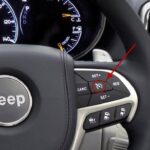The P16a0 engine code indicates an “ETC Motor Error Position” and signals a problem with your vehicle’s Electronic Throttle Control (ETC) system. This article outlines the causes of this diagnostic trouble code (DTC), how it’s diagnosed, and potential solutions. Understanding this information can help you address the issue effectively and restore your vehicle’s performance.
What Does the P16A0 Code Mean?
The P16A0 code is triggered when the Powertrain Control Module (PCM) detects a discrepancy between the commanded throttle plate position and its actual position. This malfunction can lead to various driveability issues, affecting acceleration, idling, and overall engine performance. The “ETC Motor Error Position” specifically points to a potential problem with the throttle body’s motor or its associated components. This code is often accompanied by an illuminated check engine light (MIL).
When is the P16A0 Code Detected?
The PCM monitors the ETC system continuously while the engine is running and after the throttle learn procedure has been completed. If the throttle plate doesn’t accurately track the desired position, the P16A0 code is set.
Diagnosing the P16A0 Code: A Step-by-Step Guide
Before diving into the diagnostic steps, always consult your vehicle’s specific repair manual for detailed instructions and safety precautions. Here’s a general overview of the troubleshooting process:
1. Preliminary Checks and Active DTC Confirmation
- Pre-Diagnostic Troubleshooting: Begin with a general inspection of the engine bay for any obvious issues.
- Throttle Position Sensor (TPS) DTCs: Prioritize diagnosing and repairing any existing TPS-related codes as they can directly influence the ETC system.
- P2102 Code: If the P2102 code (“Electronic Throttle Control Motor Circuit Low”) is present alongside P16A0, address the P2102 diagnostic first.
- Active or Pending: Using a diagnostic scan tool, confirm whether the P16A0 code is active (currently present) or pending (intermittently occurring). An active code requires immediate attention, while a pending code might require further monitoring or the “Intermittent Condition” diagnostic procedure outlined in your vehicle’s repair manual.
2. Throttle Plate Inspection
- Visual Examination: After turning off the ignition and removing the air cleaner assembly, carefully inspect the throttle plate and bore for any signs of coking (carbon buildup), foreign material (dirt, debris, ice), or scoring. Manually move the throttle plate to check for sticking or binding.
- Cleaning or Replacement: If coking or blockage is found, attempt to clean the throttle body. If cleaning is insufficient or damage is present, replace the throttle body assembly, remembering to disconnect the battery before removal. After replacement, perform a throttle body self-learn procedure using a scan tool. Finally, conduct a Powertrain Verification Test as described in your vehicle’s repair manual.
3. ETC Motor Assessment
- Harness Connector Inspection: Disconnect the throttle body harness connector and examine the connector and terminals for corrosion, damage, or pushed-out pins.
- Repair or Replacement: If connector issues are found, repair them accordingly. If no problems are detected with the connector, the throttle body assembly likely requires replacement. As with throttle body replacement, disconnect the battery beforehand, perform a throttle body self-learn procedure after installation, and conclude with a Powertrain Verification Test.
Conclusion
The P16A0 code indicates a problem with your vehicle’s ETC system, potentially caused by a faulty throttle body motor, coking, or wiring issues. Following the diagnostic steps outlined above can help pinpoint the root cause. Remember to consult your vehicle’s specific repair manual for detailed instructions and safety precautions. Addressing this issue promptly will restore proper engine function and prevent further damage.

